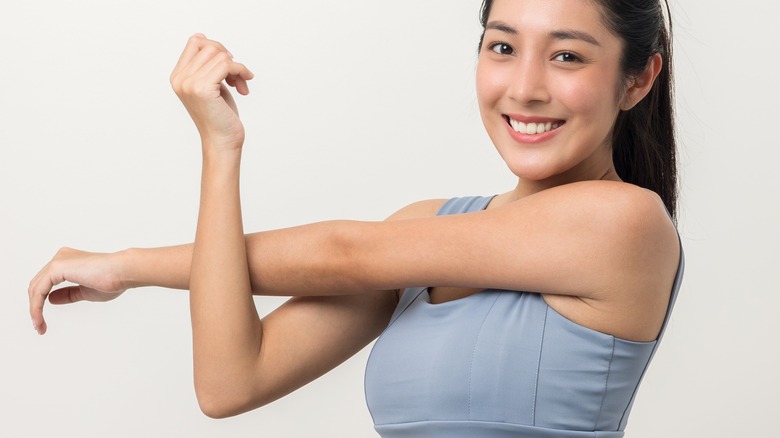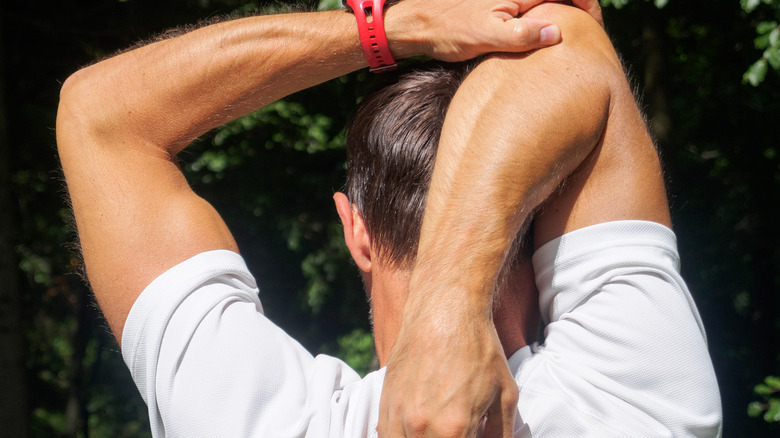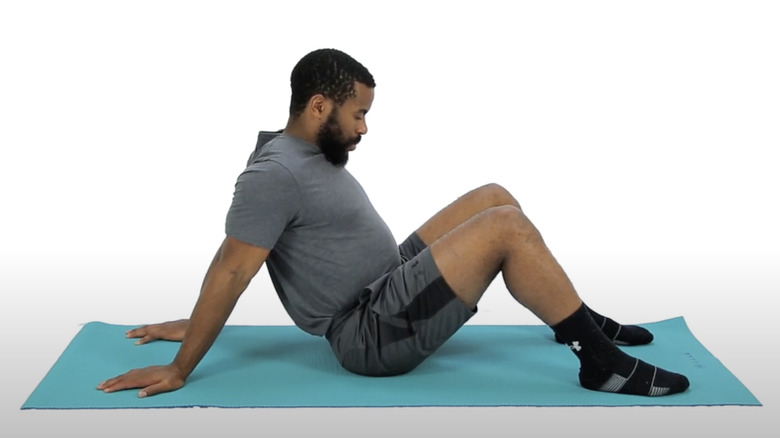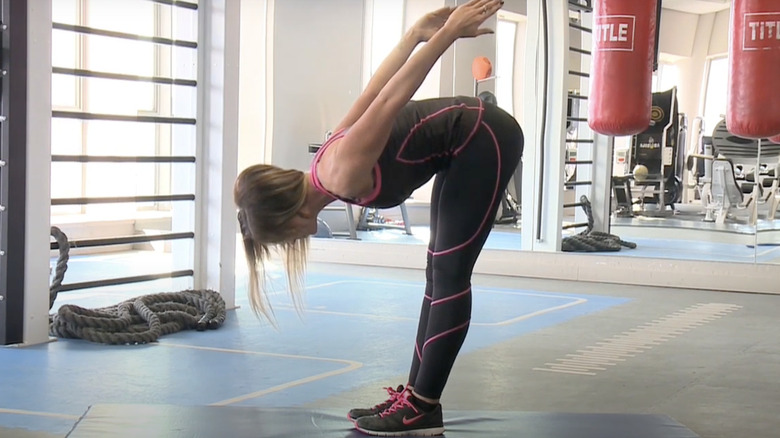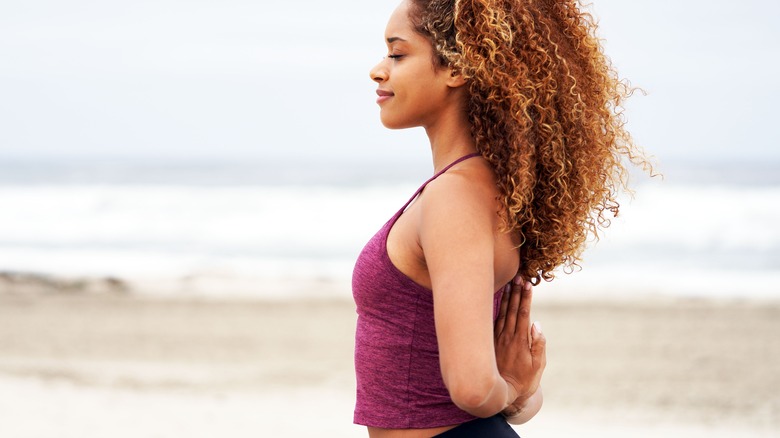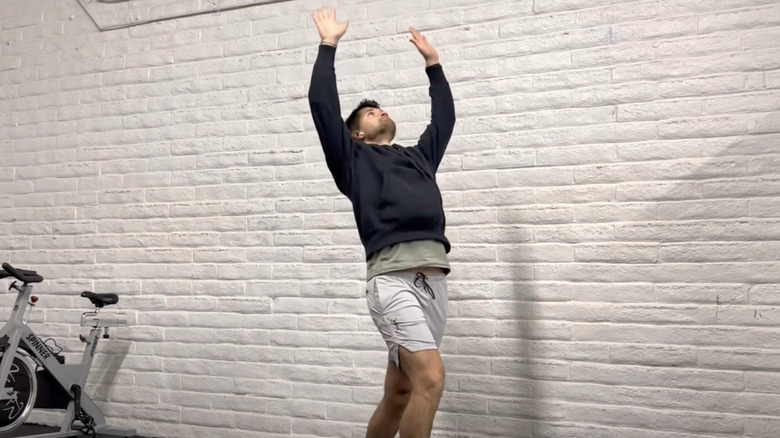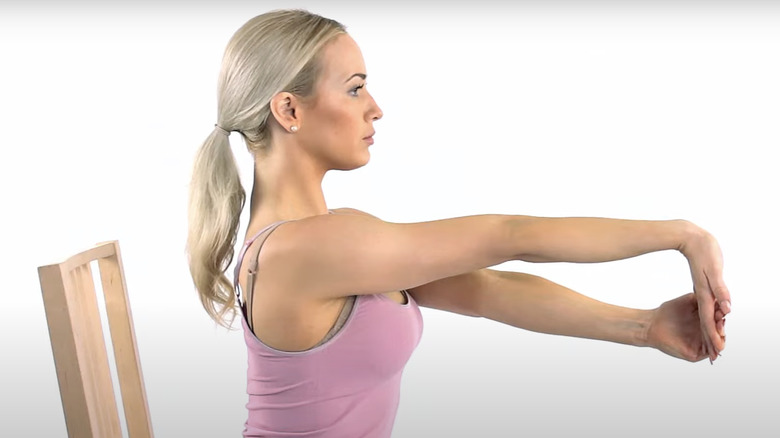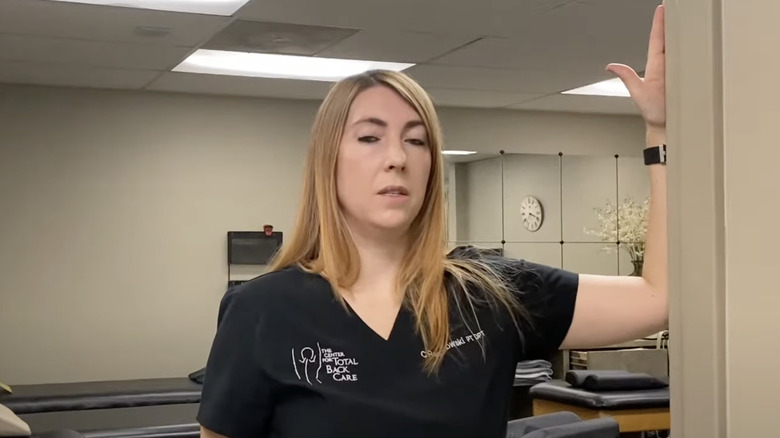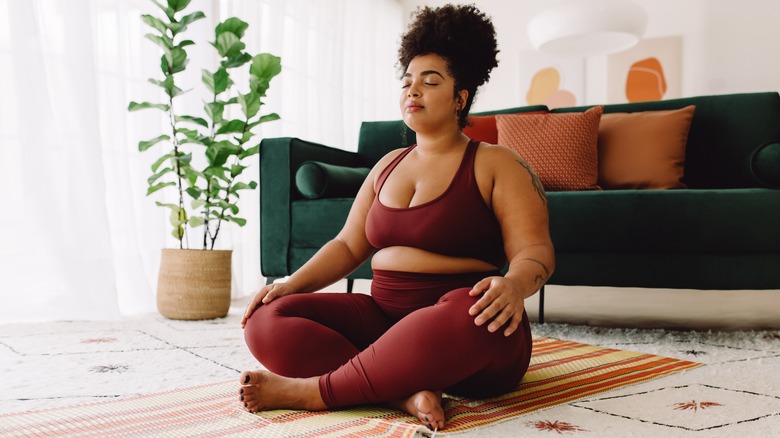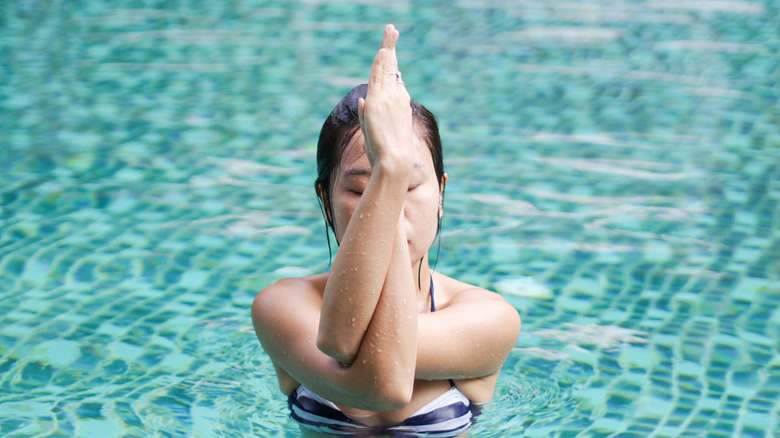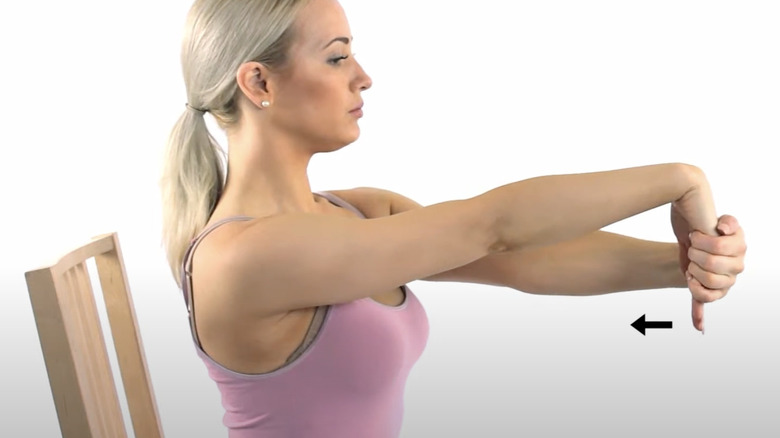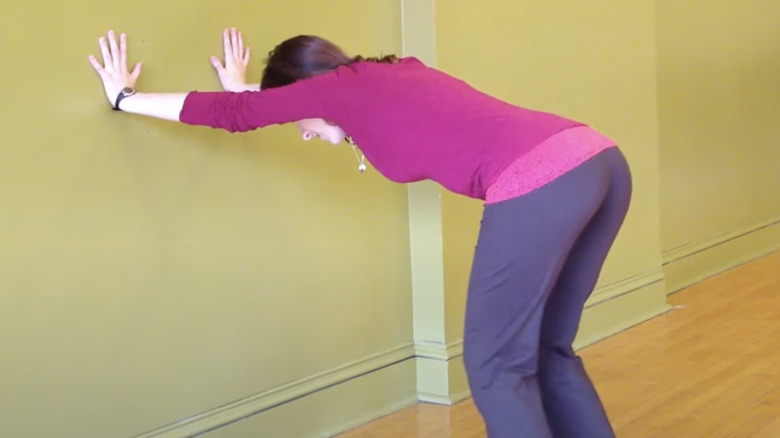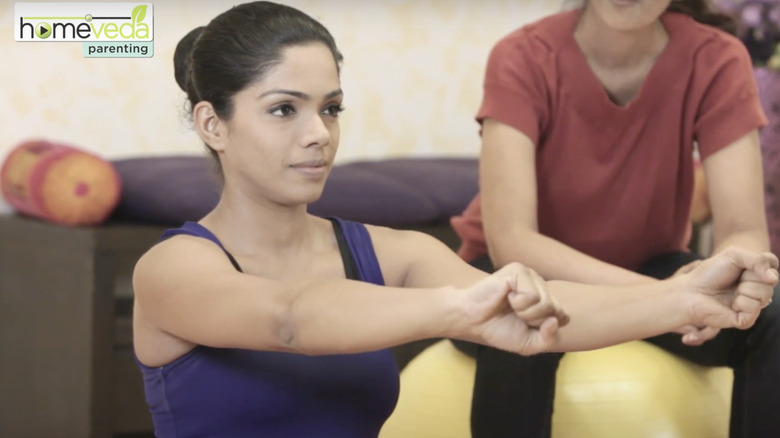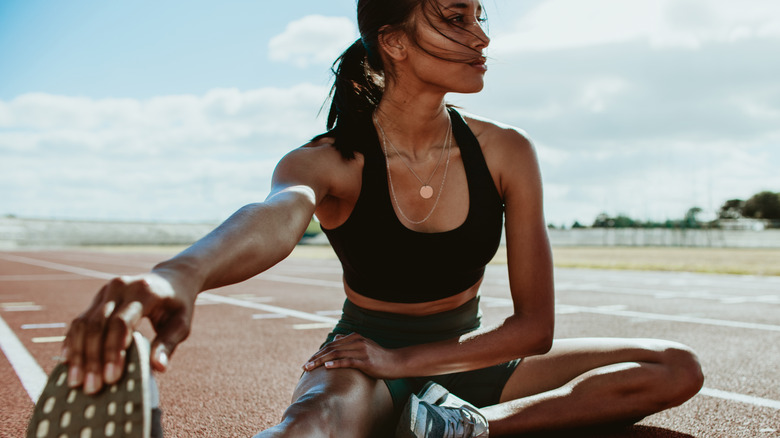Arm Stretches That Will Boost Your Upper Body Workouts
When was the last time you had a good old stretch? Go on, take a second right now and stretch it out. Feels good, doesn't it? Despite the sweet relief that stretching gives our muscles, it's pretty underrated. But incorporating stretching into your everyday life, and especially doing it around exercise, can provide some serious benefits.
Stretching helps to generate flexibility and an increased range of motion, and allows blood to get to your muscles in greater quantities, says the Mayo Clinic. All of this can allow you to reduce the risk of injury while you're working out, giving you the most effective and efficient workout possible.
But here's the thing: Most of us have a few set stretches we know, and we do them time and time again. But for your upper body and your arms, there are a huge number of stretches that you probably aren't doing, and some pretty unique ones that can boost your workouts in new and exciting ways. And here at Health Digest, we wanted to lay them all out for you.
Overhead triceps stretch
As the muscle that works to extend your forearm out from your upper arm (per Kenhub), the triceps brachii (or simply the triceps) is involved in a practically endless list of exercises and movements. And for upper body workouts that involve a lot of pressing or pushing, it's vital that you keep your triceps well-stretched, to help with recovery and flexibility, says Spotebi.
The overhead triceps stretch is one of the best movements for this, stretching out your arm muscles as well as your lats. Begin by standing upright, with your back straight and your feet planted firmly on the ground. Take one arm, raise it above your head, and then bend it, so that your forearm comes behind your neck and down the center of your back. Take your other hand and gently place the palm of it on your raised elbow. Apply some light pressure, exhaling as you do so, to move your hand further down your back, feeling the stretch through your triceps and ensuring you don't push beyond what's comfortable or safe. Hold the stretch for up to 20 seconds and then release both arms, before repeating on the other side. Make sure that your shoulders don't bunch up as you're doing this stretch.
Seated biceps stretch
The biceps typically get a lot of action when it comes to an upper arm workout, but finding ways to stretch them out can be surprisingly tricky sometimes. With a seated biceps stretch, though, you can stretch out your upper arm, shoulder, and chest muscles effectively, while also enjoying being able to sit on the floor after a killer exercise session. Win, win!
Sit on the floor, with your back straight and your legs bent in front of you, feet planted firmly on the floor (per Healthline). Place your hands behind you, so that your fingers are facing toward the back wall and your palms are on the ground. Then, gently move your butt forward towards your feet while keeping your hands in the same position. As you do so, you should start to feel a stretch through your biceps. Go as far as is comfortable, and then hold the stretch for up to 30 seconds before moving your butt back to its starting position. Rest before repeating. It can be tempting to arch your back while you're doing this stretch, but ensure that your spine stays long throughout.
Bent-over chest stretch
Okay, so your chest may not technically be part of your arms, but think about it, folks: With how much the chest gets involved during an upper body workout, why wouldn't you wanna show it a little love? From pushups to dumbbell flyes, your chest is there throughout — and stretching it out with a bent-over chest stretch keeps you limber for your workout.
As a bonus, the bent-over chest stretch also hits your front deltoids, states Prevention. Stand up straight with your feet planted roughly shoulder-width apart, and move both of your hands behind your body, clasping your fingers together. If you can, push your palms inward to each other. From here, begin to lean your upper body forward, moving from your hip joints, until your chest is bent over your legs and your hands are pointing towards the sky. Hold the position here for about 20 seconds, feeling the stretch in your shoulders and your chest. Slowly return your body to a fully standing position, before releasing your hands and resting. Repeat the stretch a maximum of three times, and enjoy the sweet flexibility it gives you. You can also do this stretch without clasping your hands together by simply holding them behind your back as you lean forward.
Reverse prayer
A good stretch involves really working into the muscles to lengthen them, and sometimes, this can be done in surprising ways. The reverse prayer, a type of yoga pose also known as Parsva Anjali Mudra, is a great example of this, providing an uncommon upper arm rotation to deliver a stretch through your shoulder muscles, as well as a decent stretch for your forearms, too (per Healthline).
Start by standing up straight, with your spine long. Take your hands and place them behind you, with your palms flat against each other, fingers pointing towards the ground. There should be a bend in your elbows. Then, on an exhale, slowly rotate your hands toward your body so that they end up pointing upwards, as though they're placed together in prayer behind you. Pushing your palms into each other will make the stretch deeper, as this will cause your hands to move vertically upward. Keep the focus by pressing in on the thumb side of your hand. Hold the stretch for around 30 seconds, and then gradually rotate your hands so that they're facing downward again, before releasing them entirely and resting.
Cross-body shoulder stretch
Our shoulders sure do a lot, huh? Not content with bearing the weight of the trials and tribulations we face throughout our lives, they're also involved in a huge amount of pressing, pushing and lifting movements while we work out. Stretching the backs of our shoulders can be kinda tricky, though, which is why we love the cross-body shoulder stretch, which also gives our upper backs a little love, as Bodybuilding says.
The best part is that the cross-body shoulder stretch is easy to do. Stand with your feet hip-width apart, and then take one arm and place it straight across your chest, so that it's pointing at the wall next to you. Then, take your other arm and place the inside of your forearm on the outside of your outstretched arm's elbow. Use the bent arm to gently pull your arm across your body, generating a stretch through your shoulder. Hold the stretch for around 20-30 seconds, breathing into it to increase it, before releasing your bent arm and allowing your outstretched arm to rest. Pause briefly, and then repeat in the opposite direction, doing another round of stretches if necessary.
Forward overhead swing
All too often, stretching involves the participant holding a static pose, usually while muttering "Ow, ow, ow" under their breath and willing their muscles to be a little more flexible. But dynamic stretching is a great alternative to this. Dynamic stretching incorporates motion to generate flexibility in your muscles, and can frequently mirror the exercise you're about to do, in order to prep your body to perform it more effectively (per Medical News Today).
A forward overhead swing is a great way to stretch out your arms and your shoulders. Begin by standing up straight, with your hands hanging by your sides (via Livestrong). From here, step one of your legs forward, and as you do so, swing your arms forward until they're over your head. In one fluid movement, step your leg back and let your arms swing back down to your side. Step the other foot forward, and repeat the same motion with your arms, alternating your feet for around a minute or so. Make sure that when you step forward, your hips come forward too, as this will help to make the stretch even more effective.
Wrist extension stretch
Let's not forget about our forearms, folks. Our forearms are involved pretty much every time we grab onto something, and that includes the weights that we're using in the gym, says Muscle & Fitness. Whether you're specifically working out your forearms or simply having a heavy dumbbell session, these muscles can become tight, and stretching them can keep your range of movement healthy.
The wrist extension stretch will activate your forearm flexors on the underside of your forearm, according to Topend Sports. To do this stretch, stand up straight, and then extend one arm out in front of your body at roughly shoulder height, with your palm facing the wall in front of you (per SELF). Take your other hand, and then hold your fingers from the outside of the palm. Gently apply pressure, moving your hand back toward you, until your fingers are pointing upwards. You should start to feel a stretch through your lower forearm, along with your wrist. Hold this position for roughly 30 seconds, making sure not to pull your hand too hard, and then release both hands. Pause, and then repeat the stretch on the other side.
Doorway stretch
That doorway that you walk through every day doesn't just act as a portal, people: It's also a premium workout aid. From squats to pull-ups, your doorway can be used for a surprising number of exercises, says Kind Body Movement & Massage. And one of the best things it can be used for is to stretch your biceps, with your chest benefitting, too.
Start by standing in the center of a doorway, and place one of your arms up against it (via Healthline). Your forearm should be flat against the door frame, with your fingers facing up to the top of it and your elbow angled at 90 degrees. Take a small step forward with the foot on the same side, and gently turn your body outward from the door frame. As you do so, you should feel a stretch start to generate through your bicep and chest. The further you step and turn your body, the more you'll feel the stretch. Hold the position for up to 30 seconds, avoiding the temptation to turn too far, before stepping your foot back and releasing your arm from the frame. Then, place your other arm on the frame in the same position, and repeat the stretch on the other side.
Assisted side bend
Your joints do a lot of work while you're working out, and if your shoulder joints are feeling especially tight or inflexible, the assisted side bend could be the stretch for you. Assisted side bends use an easy pulling motion to loosen up your shoulders, while also stretching the muscles in your arm, core, and back, says Healthline.
Sit in a cross-legged position, with your spine long and your hands resting gently by your side. Breathe in and bring your arms above your head. Then, grab onto one of your wrists with the other hand, and on an exhale, gently pull your arm over to the other side. You should begin to feel a stretch through your oblique muscles as well as your arm as you do so. Ensure that your torso and ribs don't push forward as you do this, maintaining a focus on your back remaining flat, with the only bend being a sideways one. Continue to breathe as you deepen the stretch, and then after 30 seconds or so, bring your body back to a fully upright position, releasing your arm. Rest, and then repeat the stretch on the other side.
Hooked stretch
Stretches often occur in poses that open up our bodies as wide as possible, but sometimes, bringing our bodies inward can work just as well. This is the case with the hooked stretch, which winds our arms together to stretch them out, and is particularly beneficial to your shoulders, as Yoga Journal explains. If accompanied by a similar wind through the legs, this stretch becomes an Eagle Pose, and can provide a stretch to the hips as well.
To do a hooked stretch, begin with your upper body upright (you can either do this stretch standing up or sitting in a chair), then extend your arms in front of you. Place one arm underneath the other, and hook the lower arm around the upper one, trying to touch your palms together (via Medical News Today). Bend your arms at the elbow, so that they're coming towards your body, which should activate a stretch through your shoulder muscles. Hold the stretch for up to 30 seconds, keeping your palms and your upper arms touching, before gently unwrapping your arms and returning them to your sides. Repeat the stretch on the other side to avoid any imbalances.
Wrist flexion stretch
We love our wrist flexors, and you should, too. These muscles work to move the wrist in a flexing motion, providing grip strength that's vital for pretty much any workout that requires holding on to something (via Precision Movement). But the wrist flexors can quickly become tight, compromising grip strength. Fortunately, the wrist flexion stretch is one of the best ways to elongate and loosen them.
Stand with your feet planted firmly on the floor (or sit in a chair or on an exercise bench), and then raise one of your arms so that it's straight in front of you (per SELF). Take your other hand and place it on top of your outstretched one. From here, gently press your hand down, so that it starts to fold toward the floor. You should begin to feel a stretch through the top of your forearm. Continue to press lightly to activate the stretch, holding it for around 30 seconds while breathing in and out. Release your hand and let it rest, shaking your wrist out if desired, before reversing the stretch and doing it on the other arm.
L stretch
Arm workouts can involve a lot of overhead action, and stretches that use the same plane of movement can help keep these exercises as useful as they should be. The L stretch is a stretch that does just that, getting your whole upper body involved in a move that may be especially helpful for gymnasts, yoga enthusiasts, and people with especially strong shoulders, says Prevention.
To start, you'll need to find the right spot. Position yourself in front of a sturdy object that's roughly hip height, and which you can grab onto with both hands. Place your hands on the object, and then start to step backward until your body bends into an L-shape. Breathe into the stretch, feeling it through your arms and your back (you'll also get a stretch through your hamstrings if you keep your legs straight while doing it, but let's keep our focus on the arms here, people). Hold this position for around 20 seconds, before releasing your arms and resting. Then, repeat the stretch, up to three times if you require.
Wrist rotations
Given that your wrists are involved pretty heavily when you work out your arms, it pays to keep them supple. Wrist rotations keep your wrist joint healthy and can ease stress and tension through your hand tendons, as well as the forearm muscles that are so essential for gripping (per Tummee).
Wrist rotations are especially effective as a warmup before arm workouts to loosen up your wrist joints and prepare them for holding onto weights, recommends Aaptiv trainer Jennifer Giamo (via Aaptiv). Stand with your feet hip-width apart and extend your arms out in front of your body. Gently ball your hands into fists, and then rotate them in a clockwise direction, around five times in total. Then, simply repeat in the other direction. Release your fist and return your hands to your side, or shake them out to release any tension held. And that's pretty much it! If your wrists still feel a little tight, you can repeat the exercise or rotate for a longer time.
How to stretch effectively
Knowing the best stretches to do are all well and good, but unless you're doing them right, they're not gonna be of much use.
Proper form is, of course, essential, as well as picking the right stretches for your workout, as SELF explains. Ensure that you're focusing on muscles that you've been working on through your exercise session, and don't forget to account for other muscles that may have been activated, too. Pulling exercises like chin-ups or curls, for example, can activate the lats and lower traps pretty heavily, so you'll want to include some back stretches as well.
Additionally, keep the basics at the forefront of your mind while stretching. "Slowly move into the stretch, then hold; do not bounce, it can sometimes lead to injury," explains certified strength and conditioning specialist and Bespoke Treatments Physical Therapy cofounder Dan Giordano. Ensure that you're not stretching to the point of pain, too. While a feeling of tension is normal, any significant pain should halt your stretch immediately. If you become injured through exercise, stretching probably isn't going to help that much, and may even make things worse. Lastly, make sure you're resting and recuperating any injured muscles fully before stretching them out again.

